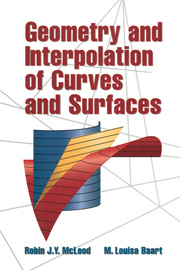Description
Geometry and Interpolation of Curves and Surfaces
Authors: McLeod Robin J. Y., Baart M. Louisa
This text gives a step-by-step approach to the production of conics, cubics, more general curves, and rational surfaces.
Language: English
Subject for Geometry and Interpolation of Curves and Surfaces:
Approximative price 57.55 €
In Print (Delivery period: 14 days).
Add to cart
Publication date: 07-2011
430 p. · 15.2x22.9 cm · Paperback
430 p. · 15.2x22.9 cm · Paperback
Description
/li>Contents
/li>Comment
/li>
This text takes a practical, step-by-step approach to algebraic curves and surface interpolation motivated by the understanding of the many practical applications in engineering analysis, approximation, and curve plotting problems. Because of its usefulness for computing, the algebraic approach is the main theme, but a brief discussion of the synthetic approach is also presented as a way of gaining additional insight before proceeding with the algebraic manipulation. The authors start with simple interpolation, including splines, and extend this in an intuitive fashion to the production of conic sections. They then introduce projective co-ordinates as tools for dealing with higher order curves and singular points. They present many applications and concrete examples, including parabolic interpolation, geometric approximation, and the numerical solution of trajectory problems. In the final chapter they apply the basic theory to the construction of finite element basis functions and surface interpolants over non-regular shapes.
1. Interpolation; 2. Conic sections; 3. Synthetic geometry; 4. Algebraic projective geometry; 5. Algebraic curves; 6. Examples and applications; 7. Surfaces.
This text gives a step-by-step approach to conics, cubics, more general curves, and rational surfaces. This approach to geometry has many practical applications in engineering analysis (such as CAD/CAM), approximation, and curve plotting. Thus the emphasis is on methods that can be used computationally. The authors start with simple interpolation, including splines. In an intuitive fashion they extend these simple procedures to the production of conic sections and more complicated curves and surfaces. Every concept is illustrated with figures and concrete examples. Professionals, students, and researchers in applied mathematics, solid modeling, graphics, robotics, and engineering design and analysis will find this a useful reference.
© 2024 LAVOISIER S.A.S.

